
Featured Breeder
Kiyoshi Kase (Koshiji Koi Farm)
|
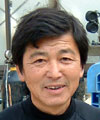 |
Each Niigata breeder has strong characters and their own unique policy. Some breeders pursue the beauty of Nishikigoi with an emphasis on Gosanke (Kohaku, Taisho Sanshoku (Sanke) and Showa), while some are always challenging to create a new variety. The breeders at Koshiji Koi Farm commit to creating a wide variety of Koi, and their ponds are always filled with color. They are the original creators of Ginga and Benikumonryu and play a significant role in stabilizing new varieties.
|
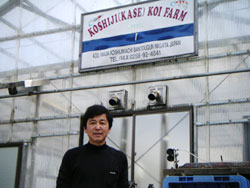 I used to be an itamae (a sushi chef). At the age of 20, I started raising Koi as a hobby, and when I turned 25, I founded Koshiji Koi Farm and devoted myself to Koi. We at Koshiji Koi Farm do a lot of research in making new varieties that nobody would think of for everybody to enjoy. In creating new varieties, I do a lot of joint work with Mr. Aoki. The Koi we create are raised in each others’ ponds so we can minimize the damage in case there are disasters. I used to be an itamae (a sushi chef). At the age of 20, I started raising Koi as a hobby, and when I turned 25, I founded Koshiji Koi Farm and devoted myself to Koi. We at Koshiji Koi Farm do a lot of research in making new varieties that nobody would think of for everybody to enjoy. In creating new varieties, I do a lot of joint work with Mr. Aoki. The Koi we create are raised in each others’ ponds so we can minimize the damage in case there are disasters.
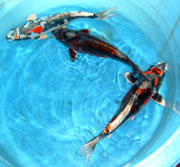 Creating a new variety takes at least 3 years no matter how hard we try, and it takes 5 years or more for commodification. I am constantly thinking about the crossings of oyagoi for the next new variety, whether it is at a Koi show looking around or whether it is when I am having a drink. We often make Hikarimono. What we do first is we cross a shiny Koi that has the potential of being an oyagoi and a Koi that doesn’t have much shine. As a result we get a medium-shining Koi. Among them, we choose a male Koi that qualifies as an oyagoi and cross him with a shiny female, and that way you get a new variety that shines nicely. I created “Ginga” this way. Ginga is a crossbreed of Kujaku and Hajiro and has a beautifully glittering pattern. I also created a variety called “Benikumonryu” by crossing Kikusui and Kumonryu. Hi normally doesn't appear on Kumonryu's body, but I first crossed a Doitsu Showa and got a Kumonryu with hi bloodline. Then I crossed it with Kikusui and successfully got a Kumonryu with hi, and that's how Beni Kumonryu came into the world. (Kumonryu with shine is Kikokuryu, Kumonryu with hi is Beni Kumonryu, and Beni Kumonryu with shine is Kin Kikokuryu.) Creating a new variety takes at least 3 years no matter how hard we try, and it takes 5 years or more for commodification. I am constantly thinking about the crossings of oyagoi for the next new variety, whether it is at a Koi show looking around or whether it is when I am having a drink. We often make Hikarimono. What we do first is we cross a shiny Koi that has the potential of being an oyagoi and a Koi that doesn’t have much shine. As a result we get a medium-shining Koi. Among them, we choose a male Koi that qualifies as an oyagoi and cross him with a shiny female, and that way you get a new variety that shines nicely. I created “Ginga” this way. Ginga is a crossbreed of Kujaku and Hajiro and has a beautifully glittering pattern. I also created a variety called “Benikumonryu” by crossing Kikusui and Kumonryu. Hi normally doesn't appear on Kumonryu's body, but I first crossed a Doitsu Showa and got a Kumonryu with hi bloodline. Then I crossed it with Kikusui and successfully got a Kumonryu with hi, and that's how Beni Kumonryu came into the world. (Kumonryu with shine is Kikokuryu, Kumonryu with hi is Beni Kumonryu, and Beni Kumonryu with shine is Kin Kikokuryu.)
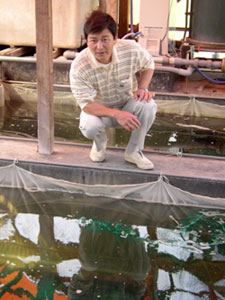 The separation method differs with each new variety. The separation method for Kikokuryu is especially unique; generally, we don’t keep totally black fry, but for Kikokuryu, we intentionally select black fry from the dai-issen (the first selection) which is approximately 40 days after birth. At a glance, their bodies are pitch black, but when you shed strong light on them as if exposing them to sunlight, you can see their patterns beneath the sumi. As the fry grow, the sumi starts to disappear and these patterns stand out. Some lose their sumi at tosai and some when they are 2 or 3 years old; that varies according to the Koi. So buying a Kikokuryu fry with sumi and raising it is one way for Koi lovers to make Koi raising enjoyable. One day you notice that the sumi is starting to disappear, and it is just wonderful to see beautiful patterns appear on a Kikokuryu’s body. The separation method differs with each new variety. The separation method for Kikokuryu is especially unique; generally, we don’t keep totally black fry, but for Kikokuryu, we intentionally select black fry from the dai-issen (the first selection) which is approximately 40 days after birth. At a glance, their bodies are pitch black, but when you shed strong light on them as if exposing them to sunlight, you can see their patterns beneath the sumi. As the fry grow, the sumi starts to disappear and these patterns stand out. Some lose their sumi at tosai and some when they are 2 or 3 years old; that varies according to the Koi. So buying a Kikokuryu fry with sumi and raising it is one way for Koi lovers to make Koi raising enjoyable. One day you notice that the sumi is starting to disappear, and it is just wonderful to see beautiful patterns appear on a Kikokuryu’s body.
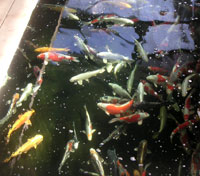 Here in Niigata, the origins of Nishikigoi, there are breeders who produce traditional varieties, and those, like myself, who are always creating new varieties. There are many people who produce many kinds of varieties, so there is almost no doubt that you can get every type of Nishikigoi in Niigata. We suffered great damage from the quake disaster, but all of the breeders are working together to protect Niigata’s Nishikigoi. I hope many Koi lovers will enjoy our Nishikigoi. Here in Niigata, the origins of Nishikigoi, there are breeders who produce traditional varieties, and those, like myself, who are always creating new varieties. There are many people who produce many kinds of varieties, so there is almost no doubt that you can get every type of Nishikigoi in Niigata. We suffered great damage from the quake disaster, but all of the breeders are working together to protect Niigata’s Nishikigoi. I hope many Koi lovers will enjoy our Nishikigoi.
|
|



